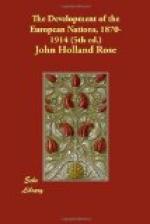[Footnote 399: This is the number as estimated by Gordon in his Journals (Sept. 10, 1884), p. 6.]
But first the battle of the routes had to be fought out by the military authorities. As early as April 25, the Government ordered General Stephenson to report on the best means of relieving Gordon; after due consideration of this difficult problem he advised the despatch of 10,000 men to Berber from Suakim in the month of September. Preparations were actually begun at Suakim; but in July experts began to favour the Nile route. In that month Lord Wolseley urged the immediate despatch of a force up that river, and he promised that it should be at Dongola by the middle of October. Even so, official hesitations hampered the enterprise, and it was not until July 29 that the decision seems to have been definitely formed in favour of the Nile route. Even on August 8, Lord Hartington, then War Minister, stated that help would be sent to Gordon, if it proved to be necessary[400]. On August 26, Lord Wolseley was appointed to the command of the relief expedition gathering on the Nile, but not until October 5 did he reach Wady Haifa, below the Second Cataract.
[Footnote 400: Morley, Life of Gladstone, vol. iii. p. 164.]
Meanwhile the web of fate was closing in on Khartum. In vain did Gordon seek to keep communications open. All that he could do was to hold stoutly to that last bulwark of civilisation. There were still some grounds for hope. The Mahdi remained in Kordofan, want of food preventing his march northwards in force. Against his half-armed fanatics the city opposed a strong barrier. “Crows’ feet” scattered on the ground ended their mad rushes, and mines blew them into the air by hundreds. Khartum seemed to defy those sons of the desert. The fire of the steamers drove them from the banks and pulverised their forts[401]. The arsenal could turn out 50,000 Remington cartridges a week. There was every reason, then, for holding the city; for, as Gordon jotted down in his Journal on September 17, if the Mahdi took Khartum, it would need a great force to stay his propaganda. Here and there in those pathetic records of a life and death struggle we catch a glimpse of Gordon’s hope of saving Khartum for civilisation. More than once he noted the ease of holding the Sudan from the Nile as base. With forts at the cataracts and armed steamers patrolling the clear reaches of the river, the defence of the Sudan, he believed, was by no means impossible[402].




